The disruption caused to the finished vehicle sector by the Covid-19 pandemic in 2020 tested the flexibility and resourcefulness of the leading vehicle handling ports in North America. The lessons learned have been useful in facing the challenges of thrown up in the last six months, writes Marcus Williams
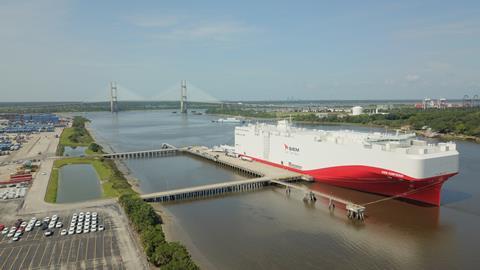
Throughput at the leading North American vehicle handling ports was down across the board last year because of the disruption caused by the coronavirus. The second quarter production and sales closures across the region meant vehicles were not moving as quickly and ports had to be flexible with storage and services. However, a fast rebound in sales in the second half of the year also required flexibility and resourcefulness across the sector.
Disruption has continued into 2021 because of production shortfalls caused by the global semiconductor supply bottleneck but vehicle flows are beginning to return to normal and the overflow spaces that a number of ports secured for their customers at short notice have largely been cleared.
Government and industry have worked together to maintain the safety of staff, and the majority of port operations continued throughout the pandemic, though social distancing measures did slow the rate at which vessels could be loaded and unloaded. Regional closures and varying rates of recovery have seen a slight shift in the records of throughput, most notably perhaps with the Mexican port of Veracruz losing ground to Baltimore for the first time in six years (see tables and click tabs for yearly comparison).
Challenges of Covid
The Covid pandemic caused production shutdowns and dealer closures globally but at different times, which disrupted the supply chain. This meant the vehicle handling ports had to find additional storage.
The port of Jacksonville on the US east coast made full use of all of its ro-ro berths, including one at its cruise terminal, which helped it maintain a fluid schedule and accommodate vehicle flows.
“Jacksonville is known for its ability to get vessels in and out quickly, a position we maintained throughout the pandemic,” assures Alberto Cabrera, director of automotive accounts at the port authority (Jaxport).
That depends in large part on close communication with its resident vehicle processors – Amports, Wallenius Wilhelmsen Solutions and Southeast Toyota. Jaxport’s Cabrera says that was key to its ability to maintain operational flexibility and keep the vehicles moving through.
“Strong partnerships when times are ‘normal’ pay off during times of volatility,” he says. “As soon as it became clear that dwell times were going to increase, we immediately began looking at options for nearby offsite storage, in case additional space was needed for vehicles.”
In the end, and thanks to that close co-operation with the terminal operators, Jaxport had enough space to accommodate the fluctuation in volumes.
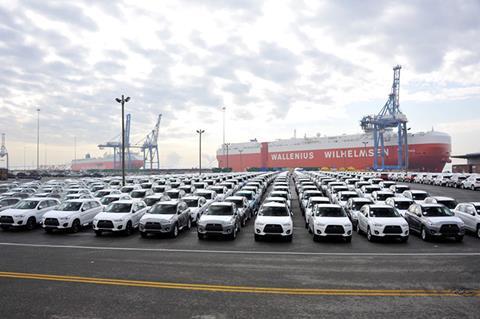
Communication, collaboration, coordination
As with the majority of ports in North America, the ports of New York and New Jersey remained open through the pandemic, despite the challenges of social distancing.
“Terminal operators and port labour adjusted safety protocols, some of which slowed select operations,” says the spokesperson for the Port Authority of New York and New Jersey (PANYNJ). “As lockdowns began to ease, pent-up demand and an increase in auto sales contributed to a robust recovery.”
Again, timely and regular communication was essential, as was closer collaboration and coordination, the three pillars of port-wide resiliency, according to PANYNJ.
“[We] worked closely with the auto terminal operators to provide flex space for what was initially expected to be prolonged storage in response to fewer people purchasing cars,” says its spokesperson. “The availability of flex space ensured continued fluidity during the late 2020 recovery of the auto business.”
Just north of the ports of New York and New Jersey, Davisville port’s terminal faced staffing challenges.
We have been really proud of our people. Through the pandemic we were able to service our customers without any hitches, we never had to turn away a vessel or a truck. They have done very well and it is a credit to our people and to the industry – Bill Kerrigan, SSA Marine
“Our biggest challenge was to maintain staff and keep them safe, working closely with and adhering to state and local mandates allowed us to keep cargo flowing but at a much higher cost,” says Matthew Martyn, director of business development, at North Atlantic Distribution (Norad), which operates the vehicle processing terminal at Davisville.
The commitment by staff to maintain operations was also something terminal operator SSA Marine paid tribute to across its North American facilities, of which there are 14 handling finished vehicles (including Manzanillo in Panama).
“Like most terminal operators we have been really proud of our people,” said Bill Kerrigan, vice-president of logistics for SSA Marine’s Automotive division. “Through the pandemic we were able to service our customers without any hitches, we never had to turn away a vessel or a truck. They have done very well and it is a credit to our people and to the industry.”
Moves in Mexico
Over on the west coast of Mexico, SSA Marine has been developing infrastructure at the port of Lázaro Cárdenas to prepare for future growth, with another 10 hectares of development recently added. Lázaro Cárdenas is one of four ports through which SSA moves vehicles in Mexico (Veracruz, Tuxpan and Acapulco are the others). The expansion at Lázaro Cárdenas in part is to handle an increase in short-sea exports north to the US west coast.
“The big change for us in Lázaro is that VW is using it for shortsea to the US west coast now,” says Kerrigan. “GM is [also] still using it for shortsea and there have been a few Mercedes shipments up the coast by shortsea.”
Amongst the VW volumes now moving through Lázaro Cárdenas are units of the Taos, which the carmaker started producing at the Puebla plant last year.
Mexican ports are handling a lot more shortsea volumes compared to a decade ago when rail moved the vast majority of vehicles north from Mexico to the US. That is because the vessel operators have more capacity and rates are lower, with those such as Grimaldi and Glovis aggressively looking for business on both coasts as a means to fill out their vessels on routes.
That business has increased port activity in Mexico and not just at the main vehicle handling ports on each coast – Veracruz and Lázaro Cárdenas.
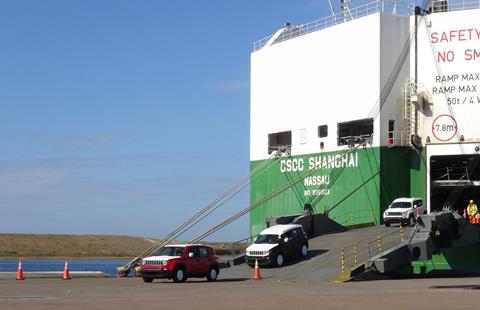
Five years ago Altamira moved around 111,000 vehicles but that had jumped in 2019 to more than 305,500 vehicles, mainly exports. While there was a 5.5% drop in volumes last year, in the first four months of 2021 the port moved around 115,000 exports and is expected to hit 350,000 units for the year, roughly what Lazaro Cardenas moved in 2020 (though that was because the pandemic caused a 27% decline in overall volumes).
What is also significant at Lázaro Cárdenas is that rail is not being used as much to move vehicles to the port for export and there has been a shift to road transport, which could either be to do with providing OEMs with more flexibility or to avoid the disruption to rail services that have been seen over recent years (a blockade last year affected Ford movements for instance).
Fast tracking the infrastructure
Further up the Pacific coast, the US port of San Diego recorded a tough 35% reduction in volumes across the year but vehicle terminal operator Pasha Automotive Services used the time to make good on enhancements to infrastructure at the National City Marine Terminal. That included major refurbishments to assembly buildings, resurfacing of parking pavements, and installation of e-vehicle chargers to support future increased volumes of EVs.
“The Pasha team took the opportunity to complete projects in one month that would typically take four-to-six months during regular operations,” says San Diego’s port spokesperson. “With reduced volumes on terminal, they completed enterprise-wide projects such as shop equipment upgrades, epoxy flooring, pavement resurfacing, re-striping parking areas, and trenching for electrical power to support e-vehicle chargers, all with little or no disruption or impact to performance of OEM activities.”
San Diego’s spokesperson say the result is that the port is now able to offer a better marine terminal for its OEM customers as volume recovers.
At the Californian port of Long Beach, operations continued through the crisis, including sustained periods of record cargo flow as the market snapped back into action. The port quickly established a Business Recovery Task Force to maintain operations across port terminals.
“We engaged and mobilised our supply chain partners,” explains Mario Cordero, executive director at the port. “We gathered and reported critical business information and began sharing it via a new webpage.”
Cordero said the port ensured personal protective equipment (PPE) reached the full extent of the workforce, including the provision of nearly 300,000 face coverings to longshore, trucking, marine terminal operators and other labour. It also opened a Covid-19 testing site for staff in the harbour district.
Today, auto processing tenants occupy 251.8 acres [102 hectares] of auto storage at Jaxport. Expanding this acreage will enable us to continue our growth and build on our role as one of the nation’s top vehicle handling ports – Alberto Cabrera, Jaxport
Academic solutions
At the west coast port of Hueneme the average weekly call of ro-ro vessels dropped from between five and six to between zero and one in May and June last year. That reduced inbound flow of vehicle inventory helped the port alleviate the backup of retail freight, which was increased by the widescale switch to online sales during the lockdown.
However, the vehicles that were offloaded often did not have an immediate onward destination because of dealership closures. That amounted to up to 35,000 vehicles in Hueneme’s case and the port worked with local universities and colleges to be able to use their unused parking lots when required.
“The added time (as needed by our customers) at first point of rest on-port, and [with] options off-port for space to park cars through our local partners, allowed for a steady supply of autos to be shipped to the dealers once the sales started to flow again and ship arrivals resumed,” says Hueneme’s spokesperson. That ability to help OEM customers stabilise their supply chains through greater flexibility helped strengthen relationships with OEM customers, according to the company.
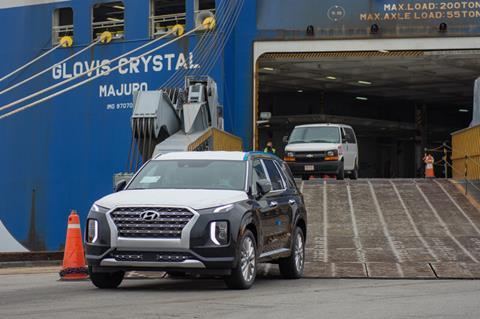
Further north at the port of Portland in Oregon state, volumes were down 23% for 2020 and labour issues affected throughput. Portland’s spokesperson said the decrease in the number of drivers allowed on a ro-ro vessel was decreased, which along with the labour shortage onshore, impacted the speed at which vessels were being loaded and discharged.
As indicated above, flexibility was key in dealing with the disruption caused to vessel calls and the requirements for excess capacity at the beginning of the crisis.
“We have about 25 acres of overflow space to help with surges, which gives us the flexibility to quickly add laydown space as needed,” says Portland’s spokesperson.
Vehicle flows are now returning to normal and those overflow spaces have emptied out again, including the one Portland set up at the nearby airport. However, the microchip shortage continues to postpone a full return of volumes.
In terms of staffing, there have been restrictions on the movement of labour, particularly longshoremen, and this has been an issue for ports looking to cover available shifts during sickness or absenteeism. There are now signs that this restriction is being lifted and workers will be able to travel.
“This is a great tool to help share the burden, [but] which has been suspended since March 2020,” notes Portland’s spokesperson. Its looking like the use of travellers may start back up in July, which is a useful tool for ensuring adequate labour supply during busy periods.”
Steady volume increases
The rebound in consumer sales is continuing strongly through 2021 and inventory levels in the US at least have not been as low for a decade. The other factor influencing this is the production shortfalls being caused by the semiconductor crisis but, according to forecasts by North Automobile Dealers Association (Nada), June was probably the last month for this pinch on inventory and volumes are expected to rebalance into 2022.
For the ports, the substantial increase in sales has led to shorter dwell times at the vehicle terminals.
Back on the US east coast, Jaxport forecasts that volumes would continue to grow as the supply chain stabilised. More specifically, consumer demand is driving steady volumes and the port expects to see them approach pre-pandemic levels by the end of this year. Furthermore, the port authority anticipates growth beyond its previous record of nearly 700,000 vehicles by 2022.
Supporting this the port also has a regionally specific vehicle consumption pattern that is bringing more trade its way.
“The rapid growth in Florida’s population, and our proximity to the growing central Florida market, are also contributing to strong volumes,” says Alberto Cabrera.
Jaxport recently signed a memorandum of understanding (MoU) with central Florida’s Volusia County to highlight the logistics benefits of moving cargo bound for the region through its facilities.
Sustainable growth
As volumes return, North American vehicle handling ports are also looking to the need for greater sustainability in operations. The automotive industry is looking for ways to make its outbound supply chain cleaner in line with the efforts being made at an industry and governmental level to clean up the vehicles it makes.
That is also to Jaxport’s advantage because it provides liquified natural gas (LNG) refuelling for the latest ro-ro vessels.
“Vessels are able to bunker here, and vehicle carriers are embracing this option,” Cabrera points out. “For example, Siem Car Carriers’ two new LNG-powered ships, commissioned by Volkswagen, regularly call at Jaxport.”
The first call, by the Siem Confucius, was made in July last year with VW volumes from Mexico dropped off at the Blount Island marine terminal.
In fact, trade with Mexico is growing and Jaxport is the closest major US east coast port with the capabilities to handle large volumes, according to Cabrera. Expanding vehicle capacity to handle more vehicles is one of the four main parts of its 2020-2025 Strategic Master Plan, as is maintaining congestion-free berths.
“Today, auto processing tenants occupy 251.8 acres [102 hectares] of auto storage at Jaxport,” he says. “Expanding this acreage will enable us to continue our growth and build on our role as one of the nation’s top vehicle handling ports.”
Volumes are also up strongly at PANYNJ, with an 11.5% year-on-year increase in the first quarter, but it is one which is line with 2019 volumes. While ongoing Covid complications and the semiconductor shortage have slowed what was projected to have been a strong growth period in the first half of the 2021, volumes are increasing and the port forecasts more volumes in the fourth quarter of this year, including those from Mexico.
Like Jaxport, PANYNJ has its own roadmap for the future – Port Master Plan 2050. The new 30-year plan follows an extensive review of more than 3,000 acres of port property
At the end of 2020, Berth 25, which predominately serves Toyota, was put back into service after a major reconstruction.
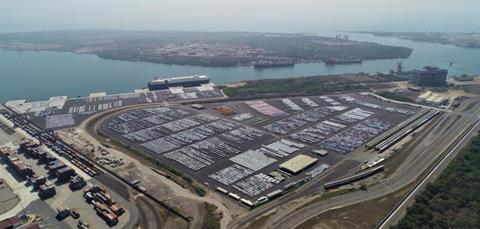
LNG vessel calls
The first quarter of 2021 also saw developments in infrastructure at Davisville, which opened a new berth on the east face of Pier 2. That new berth is allowing Norad to rehabilitate the south face with minimal disruption. The company will end up with three usable ro-ro berths for the latest vessels once all the work is complete. That includes for Siem Car Carriers LNG vessels, which are now making regular calls at Davisville with VW volumes, including the new ID.4 electric vehicle. Martyn said NYK’s forthcoming fleet of LNG vessels would also likely be calling at Davisville.
Furthermore, the port has been approved for a fourth berth, which will allow Norad to handle more volume for OEMs, including in the used vehicle sector. In late summer 2020 Sallaum Lines began using Davisville as a port stop for its West Africa cargo (shipping line Glovis is actually carrying the vehicles to West Africa).
“While we will always be fully dedicated to new cars, the used market provides vessel lines with a cargo balance that will entice further calls,” says Martyn. “[It also offers] the ability to offer OEMs exceptional rates to come to Norad in Davisville, where the wharfage is the least expensive of any North American Atlantic port.”
Norad has also been developing storage space inland at Davisville and has created new parking lots as haulaway truck bays, something that is facilitating a faster turnover of vehicles and helping to expedite shipping.
Environmental reviews
On the west coast San Diego has recently completed the first phase of a modernisation project at its Tenth Avenue Marine Terminal. That involved demolishing two unused warehouses to create additional laydown area for the large project cargo the port receives. That has already resulted in additional business for the port and as part of the project San Diego will be adding more electrified equipment to handle the cargo.
An environmental review is underway at the port’s National City Marine Terminal for a project that will help improve operations, increase trade and add jobs, according to the spokesperson for San Diego: “The new land use plan will include a road closure that will provide the terminal with more contiguous space to improve terminal efficiency. It will also include rail efficiencies with connector track.”
We are investing $1.7 billion in strategic projects over the next 10 years to enhance marine terminal productivity, deliver greater efficiency to our customers and improve the sustainability of our operations – Mario Cordero, Port of Long Beach
The port has also been studying ways to improve mobility and safety for users of Harbour Drive, a main link between the two cargo terminals at San Diego and the maritime industrial businesses on the waterfront.
San Diego port expects volumes to be slightly lower in the second and third quarters of this year because of production shutdowns caused by the semiconductor issue. However, it does forecast a strong rebound in Q4 and predicts heavy volumes into 2022 as the industry responds to pent up demand for new vehicles and restores inventory at the dealers. “With our new terminal enhancements in place, we are well positioned to support the volume recovery,” says its spokesperson.
At the port of Long Beach work is ongoing to consolidate and streamline Toyota’s existing operations at Pier B, which will include a hydrogen fuel cell plant. “The port of Long Beach and Toyota have been partners for more than a half century [and] its exciting to see us evolve together with a focus on sustainability and efficiency,” says the Cordero.
In terms of that sustainability, Long Beach is working with the neighbouring port of Los Angeles on the Clean Air Action Plan (Caap), which the ports first set up in 2006, described by Cordero as “a sweeping, innovative and comprehensive strategy to tackle every source of port-related air pollution”.

The Caap was last updated in 2017 and now has goals of establishing a zero-emissions cargo handling equipment fleet by 2030, as well as zero-emissions drayage trucks by 2035.
Cordero said that the port’s industry partners deserved a great deal of credit for cleaning the air at Long Beach and that last year it welcomed the K-Line Century Highway Green vehicle carrier, one of the first LNG-powered vessels to call at the port of Long Beach.
Looking ahead, Cordero says Long Beach is investing in sustainable efficiency for operations.
“We are investing $1.7 billion in strategic projects over the next 10 years to enhance marine terminal productivity, deliver greater efficiency to our customers and improve the sustainability of our operations,” he says. “Even during a global pandemic and ongoing trade war, seaports must invest in infrastructure and technology to offer the service and facilities the goods movement industry requires.”
The port of Hueneme is also focusing on sustainability with its customers and partners to green up operations. The port authority is making efforts to get port equipment down to zero emissions.
“As part of our 2030 Strategic Plan, we have planned for two new pillars on social equity and infrastructure that encompass being able to grow in a sustainable manner while improving air quality,” says Hueneme’s spokesperson.
As with the port of Long Beach, as part of its strategic plan Hueneme is working on replacing conventional diesel trucks on site with low emission propane-fuelled trucks, and electrifying cargo handling equipment to reduce on-dock emissions.
The port expects strong volumes through to the end of this year as the economy rebounds and one of its next big terminal projects is to establish more parking structure for first point of rest/last point of rest. “We are [also] working on offsite locations to support the automotive segment business [and there is] longer term development of land for port processing facilities, within 2.5 miles (4km) of the port’s gate,” says the ports spokesperson.
Hueneme is also looking at implementing a cargo tracking terminal operating system in the next few months to help with port cargo flows.
Developments in Vancouver
In terms of sustainable infrastructure at the Canadian port of Vancouver, the port authority is working with Fortis BC and the British Columbia provincial government toward having an LNG bunkering service from 2024.
A spokesperson for Vancouver Fraser Port Authority says that the latest generation of LNG car carriers are now calling at the port, including NYK’s Sakura Leader, which first called at the Annacis Island Auto Terminal in November last year. The vessel is one of the world’s largest car and truck carriers, handling approximately 7,000 vehicles per voyage. In April this year the aforementioned K Line vessel Century Highway Green, also called at Vancouver.
The bigger vessels can be accommodated at Vancouver since the introduction of new inland domestic vehicle compounds, which has increased capacity for the Vancouver gateway and created an opportunity for the Annacis Auto Terminal to handle increased import volumes.
The port authority’s spokesperson says it is working with terminal operator WW Solutions to further enhance capacity and improve efficiencies that will allow the Annacis Auto Terminal to handle long-term growth within the sector.
Along with terminal facility upgrades, Vancouver has good on-dock rail connections into North America, in collaboration with Canadian Pacific.
SSA Marine’s terminal at Nanaimo on Vancouver Island is also moving volumes. The company started working with Nanaimo Port Authority (NPA) and transport facility builder TransDevelopment Group on a multipurpose terminal on Vancouver Island for vehicle imports back in 2017 and is moving Mercedes-Benz volumes through the facility.
Looking ahead, Kerrigan says that the industry as a whole has to look at making throughput at the North American ports more efficient, rather than pushing vehicles out of the plants and having them sit at the ports for weeks waiting for vessels. One answer could be in a return to vessel sharing agreements, which fell out of favour following the anti-trust investigations that dogged the finished vehicle sector over the last ten years (starting here).
“There is a fixed capacity out there and I would love someone to tell me what the utilisation is on these carriers on a worldwide basis,” said Kerrigan. “There is a lot of potential to do more vessel sharing and it would greatly alleviate a lot of the congestion problems we have at the ports.”

























![Global[1]](https://d3n5uof8vony13.cloudfront.net/Pictures/web/a/d/s/global1_726550.svgz)




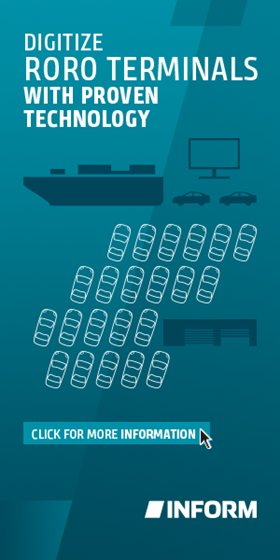









No comments yet